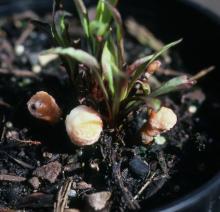See:
Marigold (Tagetes spp.) - Fusarium Wilt
Cause Fusarium oxysporum f. sp. callistephi, a fungus that is soilborne, remains indefinitely, and also is carried on the seed and seed debris. It survives for years in the soil as thick-walled, dormant chlamydospores. These spores germinate in response to exudates from nearby plant roots. Hyphae then penetrate the roots, colonize the cortex and move into the xylem tissue. Small spores, microconidia are produced and carried up into the plant. At least 4 races have been identified. Races of the fungus routinely overcome resistant plants.
Symptoms Damping-off of young seedlings is common where the stems rot at the soil line, fall over, and die. Older affected plants that survive may be severely stunted, have brown lower leaves and can wilt during the heat of the day. Sometimes a one-sided wilt development occurs on stunted plants. Brown discoloration of vascular tissue often is noticeable in tissue near base of stem. Wilting of lower leaves is common, as is the drooping of flower heads.
Cultural control
- Use wilt-resistant cultivars. The 'Matsumoto' cultivars have moderate resistance including 'Matsumoto Salmon', 'Matsumoto Formula Mix', and 'Matsumoto Yellow'. 'Fan Mix' has had variable results.
- Seed treatment is helpful. After removal of all other plant debris, a 30 min. soak in 1% bleach has been effective.
- Use plants from soil known to be disease free.
- Plant in soil known to be disease free or use soilless potting mix.
- Preplant soil solarization has been helpful in reducing populations of certain soilborne pathogens and weeds in western Oregon. Place clear plastic (preferably anti-condensation film) directly on smooth, rototilled ground, which has been irrigated to field capacity and then allowed to drain for 1-2 days. Bury the edges of the plastic to trap the heat. Solarize for 4-6 weeks (or longer) during the hottest part of the summer, beginning in early- to mid-July.
- Avoid reusing pots or trays from a previous crop for propagation. If pots must be reused then wash off all debris and soak in a sanitizing solution or treat with aerated steam for 30 min.
- Destroy all infected plants.
- Do not spread soil from diseased to healthy areas.
Chemical control Not effective as a sole treatment but must be integrated with cultural controls. Use these materials preventively only at seeding or transplanting. Do not use to salvage the crop, as treatments are generally ineffective and only help increase the risk of developing resistant fungi.
- Banrot 40 WP at 4 to 8 oz/100 gal water. Group 1 + 14 fungicide. 12-hr reentry.
- Heritage at 1 to 4 oz/100 gal water plus a non-silicone-based wetter sticker. Group 11 fungicide. 4-hr reentry.
- Medallion WDG at 1 to 2 oz/cubic yard of potting media or at 1 to 2 oz/100 gal water drenched into the transplant or cutting root zone. Group 12 fungicide. 12-hr reentry.
- Spirato GHN at 1 to 2 fl oz/ cubic yard of potting media or at 1 to 2 oz/100 gal water drenched into the transplant or cutting root zone. Group 12 fungicide. 12-hr reentry.
- Terraguard SC at 4 to 8 fl oz/100 gal water. Group 3 fungicide. 12-hr reentry.
- Preplant soil fumigation has been shown to reduce fugal populations and maintain disease at a low level.
Reference Elmer, W.H. and McGovern, R.J. 2013. Epidemiology and management of fusarium wilt of China asters. Plant Disease 97:530-536.


